How to grow fuchsias
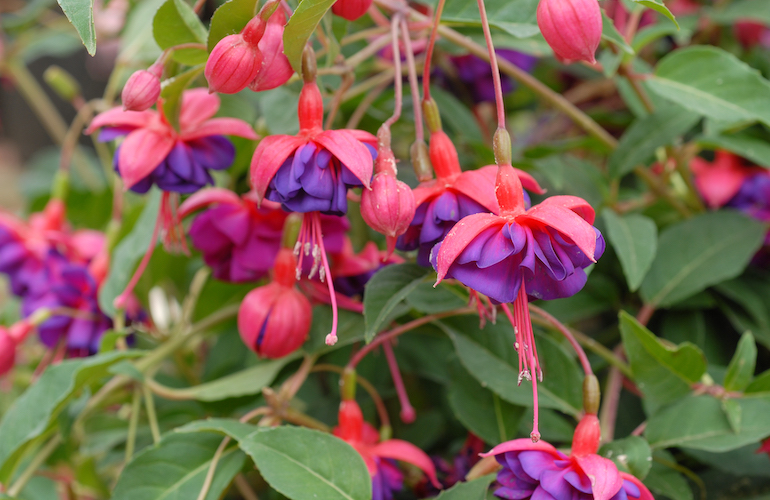
Here is our guide to growing fuchsias, full of expert advice to help your fuchsias thrive
Image: Fuchsia 'Dollar Princess' (Hardy) from Thompson & Morgan
Fuchsias are versatile, hard working shrubs that will flower virtually all summer long. For a reasonably small amount of effort, you’ll be rewarded with a glorious show of pretty pendant flowers.
Fuchsia plants grow happily in sun or partial shade, whether planted in borders, beds, window boxes, hanging baskets and containers. In fact, they bring colour to almost any position that you can shake a trowel at. You can choose between evergreen or deciduous varieties.
Many people don't know that the small purple fuchsia fruits are edible – although some are more palatable than others! Fuchsia splendens is considered to have one of the best flavours; the citrus-flavoured berries have a peppery aftertaste that works well in jams. Just another reason to consider these beautiful plants for your garden.
How to choose a fuchsia
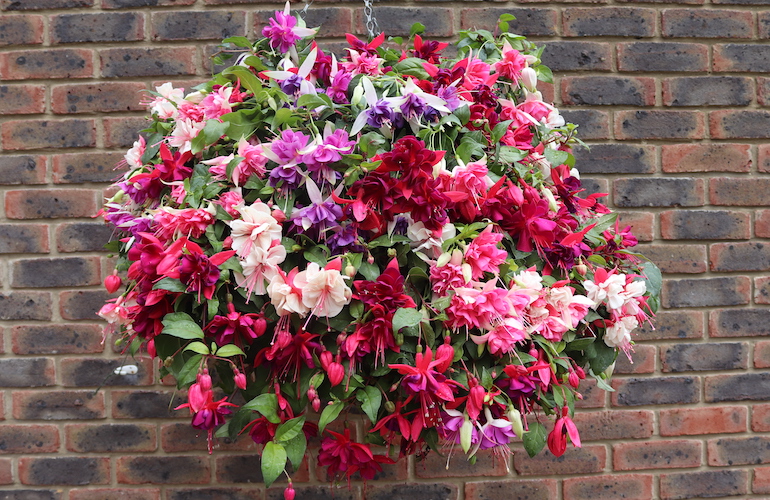
Several varieties of fuchsias will happily grow in hanging baskets.
Image: Fuchsia Sparkling Giant Collection from Thompson & Morgan
A great addition to large or small gardens, fuchsias can trail and climb, as well as grow in beds, borders or baskets. Here are the main types:
- Trailing fuchsias: perfect for hanging baskets and patio containers.
- Upright/bush fuchsias: these bushy rounded shrubs are ideal for growing in borders and patio containers. Some of the larger varieties such as Fuchsia magellanica and Fuchsia riccortonii even work well as hedging.
- Climbing fuchsias: with a very rapid growth habit and long, lax stems, these fuchsias can be trained onto obelisks or against walls and fences for a spectacular vertical display.
- Standard fuchsias: upright or bush fuchsias can be trained as standards, making them superb specimen plants for patio containers.
Popular fuchsias
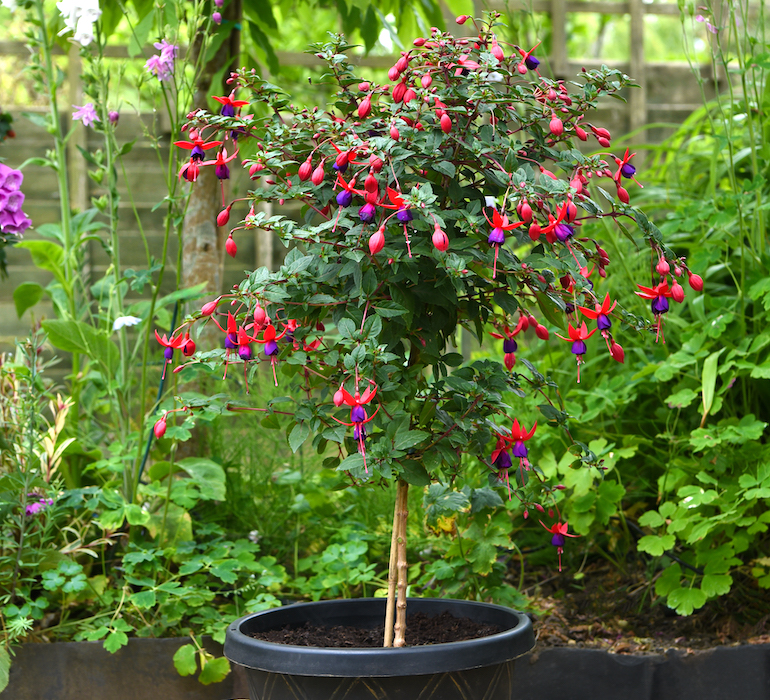
This new standard fuchsia is perfect for containers or borders
Image: Fuchsia 'Angela' from Thompson & Morgan
There are so many types of fuchsia that it can be difficult to choose – take a look at our quick video to see some of the best fuchsia plants on our trials ground.
Spoilt for choice? Here is a list of some of our all time favourites:
- Fuchsia Giant-Flowered Collection (Half Hardy): With big, frilly blooms, these colourful, trailing showstoppers come in a wonderful mix of colours. Ideal for baskets and window boxes.
- Fuchsia 'Shrimp Cocktail' (Hardy): Resilient and hardy, this variety is a fusion of marbled hot pink petals with a candy blush; each bloom totally unique and almost luminous against the dark foliage. A truly exceptional plant when planted in borders and patio containers.
- Fuchsia 'Dollar Princess' (Hardy): With an RHS AGM for its excellent garden performance, this bushy variety is popular for its profusion of double purple blooms with contrasting cerise pink sepals. A lovely compact specimen that works well in patio containers, wildlife gardens, or planted at the front of mixed borders.
- Fuchsia 'Hawkshead' (Hardy): This beautiful hardy fuchsia boasts dark green leafy stems, hung with dainty white flowers that are suffused with a trace of green at the tip.
How to grow fuchsias
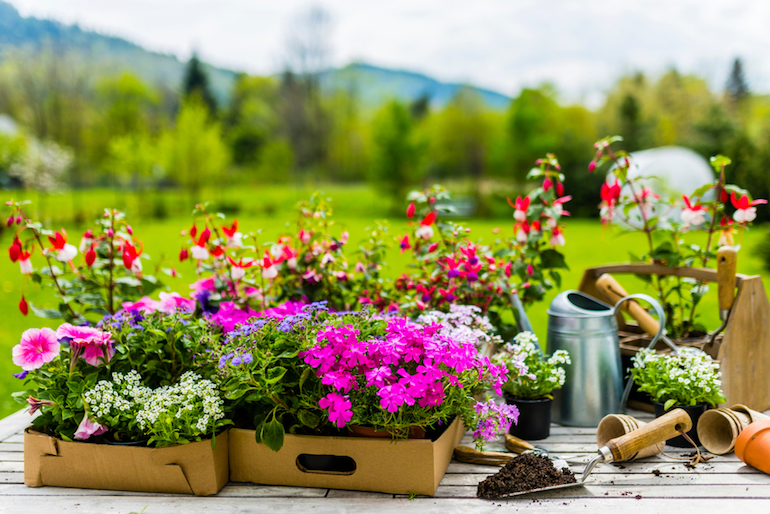
Get your fuchsias started in warm, frost-free conditions before planting out.
Image: Shutterstock
Fuchsia plug plants should be potted up using a good quality, well-drained compost and grown in warm, frost-free conditions. Trailing fuchsia plug plants, meanwhile, may be planted directly into baskets, window boxes and containers. These should also be grown on in warm, frost-free conditions until they’re well-developed.
To promote busier growth and more flowers, pinch out the growing tips of each plant while they’re still small. If you need a few tips on how to pinch out the stems, watch our helpful video:
When all risk of frost has passed, gradually acclimatise fuchsia plants to outdoor conditions over a 7 to 10 day period, before moving them (or planting them out) in their final positions.
When planting your hardy fuchsias in the ground, the base of the stem should be 5cm (2 inches) below the soil surface. This will help to protect the crown of the plant during cold winter weather.
Fuchsias are wonderfully versatile and will happily grow in sun or partial shade in any fertile, moist, well-drained soil. However, they do appreciate some shade during the hottest part of the day and a bit of shelter from cold winds.
Feeding and watering fuchsias
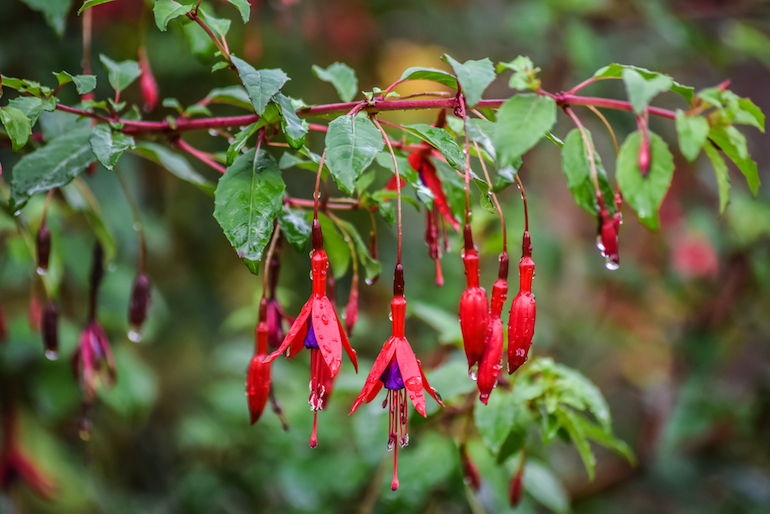
Moist but not waterlogged conditions are ideal.
Image: Shutterstock
Fuchsias like to be watered regularly; you want to maintain moist but not waterlogged conditions.
Those that are grown in containers will need frequent watering, depending on the weather conditions, and those in hanging baskets should be watered at least once a day during hot summer weather. Fuchsias that are planted directly into borders should be kept moist, but will quickly become more self-sufficient once established.
Although many fuchsia plants are naturally floriferous, feeding them every few weeks throughout the summer with a soluble fertiliser (especially those grown in hanging baskets and containers) is well-worth the few minutes of effort. After all, regular feeding will encourage an endless supply of flowers. Deadheading the plants frequently will also prolong the flowering period.
How to prune fuchsias
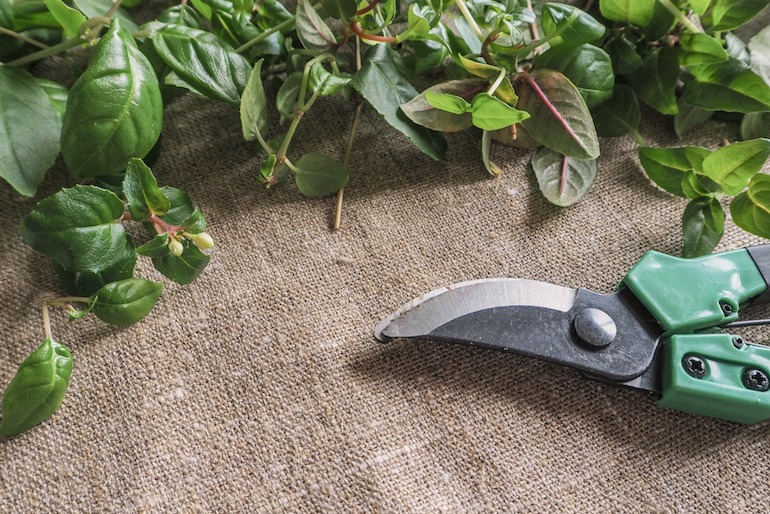
Prune your fuchsias in spring.
Image: Shutterstock
How you prune your fuchsia depends on the variety. But it’s fairly simple either way:
- Upright/bush fuchsias: Best pruned in spring, you should cut back the stems to a permanent low framework.
- Climbing fuchsias: Prune out the oldest stems in spring when the fresh buds begin to break, and reduce the remaining stems to restrict their vigorous growth to the available space.
How to train a standard fuchsia
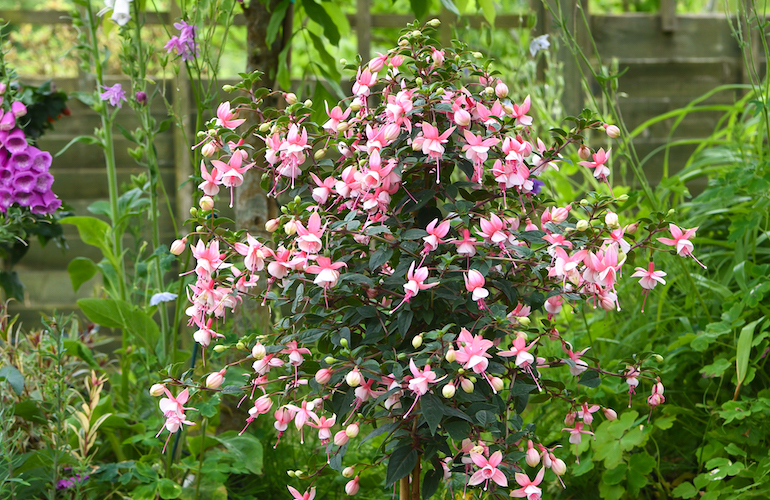
A little effort to create a standard fuchsia creates a superb plant
Image: Fuchsia 'Elma' (Hardy Standard) - new from Thompson & Morgan
Growing fuchsia standards isn’t difficult, but it can take up to 18 months to train your plant correctly. To achieve a spectacular specimen plant which has a clear main stem topped with a dense head of foliage, you’ll need to practise ‘pinch pruning’. Here’s how:
- Allow your young fuchsia stem to grow upright, removing all sideshoots as they develop. Don’t remove the leaves from the main stem, however, as these will feed the plant.
- Tie the main stem to a cane to provide support as it grows.
- Once the fuchsia plant is 20cm (8 inches) taller than the desired height, pinch out the stem tip.
- New sideshoots will be produced at the top of the plant, which will form the head of the standard. Pinch out the tips of each sideshoot when it has 2-4 sets of leaves. Continue pinch pruning until a rounded head has formed.
- The leaves on the main stem will be shed naturally in time, or you can carefully remove them.
How to care for fuchsias over the winter
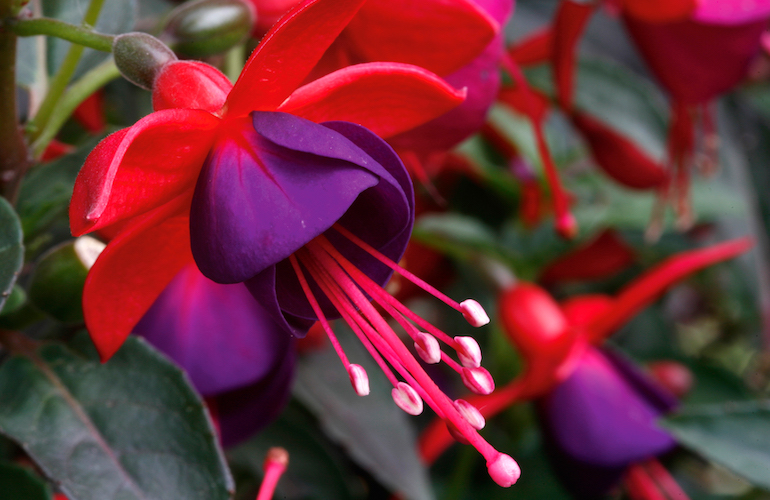
Some fuchsias such as 'Jollies Nantes' benefit from wintering in the greenhouse.
Image: Thompson & Morgan
Wintertime can be tough for many plants, but hardy fuchsia plants are usually happy in sheltered borders all year round. Whether you’ve chosen a neat compact variety, such as Fuchsia Tom Thumb, or Fuchsia Magellanica, which can reach colossal heights, hardy fuchsias are best planted deeply in the ground to protect the crown during cold winter weather. But you can also give them added protection during this time by applying a deep mulch of bark chips, leaf mould or straw in late autumn each year.
Half-hardy fuchsias tend to be grown as annuals in many UK gardens, but they can be easily overwintered in a dry, frost-free greenhouse during the coldest months. Many of the most popular fuchsia cultivars for hanging baskets and patio pots are half-hardy fuchsias.
Standard fuchsias will need to be moved to a frost-free position during the winter months to protect their vulnerable stem from frost damage. You should do this regardless of how hardy the variety is.
Have you been inspired to grow fuchsias? Let us know how you get on over on our Facebook page. And for even more help and information on fuchsia growing and care, visit our hub page for links to other online resources.
Quick guide:
How do you grow fuchsia plants?
Fuchsias are incredibly versatile plants that grow happily in sun or partial shade, and can be planted in borders, beds, window boxes, hanging baskets and containers.
What is the best fuchsia to choose?
There's a wide choice of evergreen or deciduous fuchsia varieties. For hanging baskets choose a trailing fuchsia. Upright/bush fuchsias are ideal for growing in borders and patio containers. And climbing fuchsias can be trained onto obelisks or against walls and fences for a spectacular vertical display
When do you prune fuchsias?
Prune upright/bush fuchsias in spring - simply cut back the stems to a permanent low framework. For climbing fuchsias prune out the oldest stems in spring when the fresh buds begin to break, and reduce remaining stems so their vigorous growth is restricted to the space you have available.

Written by: Sue Sanderson
Plants and gardens have always been a big part of my life. I can remember helping my Dad to prick out seedlings, even before I could see over the top of the potting bench. As an adult, I trained at Writtle College where I received my degree, BSc. (Hons) Horticulture. After working in a specialist plantsman's nursery, and later, as a consulting arboriculturalist, I joined Thompson & Morgan in 2008. Initially looking after the grounds and coordinating the plant trials, I now support the web team offering horticultural advice online.Sign Up For Exclusive Special Offers




© 2024 Thompson & Morgan. All rights reserved. A division of Branded Garden Products Limited.





